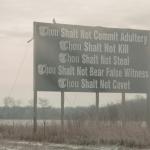Evangelicals generally classify interpretations of Revelation as futurist, historicist, idealist, or preterist.
For futurists, the book of Revelation describes the events leading up to the end of the space-time universe, the final coming of Jesus. Futurist interpretations need not be pre-millennial, but they often are.
Historicist read Revelation as an allegory of the history of the church. This was popular among Reformers, who identified the Catholic Church with the false bride, the whore Babylon.
Idealist claim that the book is not predicting any specific series of events, but giving a symbolic portrait of perennial spiritual battles.
Highlighting the “soon” passages at the beginning and end of Revelation, preterists claim that Revelation is about events of the late first century or shortly after. This takes various forms. It can take the form of a focus on the Jewish war; it can focus on the church’s early history; or it might extend somewhat further to predict the fall of Rome.
An example will clarify the differences. (I’m drawing on Steve Gregg’s very useful discussion of the trumpets in Revelation, Four Views: A Parallel Commentary, 148-9).
For historicists, “the first four trumpets represent the four great blows that fell upon the Western Empire from the beginning of the fifth century to its fall in 476.” Some suggest that the images of hail, fire, and blood “symbolize war and the bloodshed and destruction of vegetation that accompany it.” Specifically, “Most interpreters identify this first trumpet with the military conflicts between the Western Roman Empire and hordes of Goths and Vandals under Alaric. . . . The Goths attacked Gaul, Spain, and Italy from the north, burning or destroying everything in their path.” In the first decade of the fifth century, they besieged Rome itself three times.
Preterists often connect the trumpets with events leading up to the outbreak of the Jewish War in 66 AD. Gregg quotes one writer’s view that the first four trumpets “probably predict the several years of ravage and pillage prior to the destruction of Jerusalem itself. In this period, the land suffered terribly. The plagues are reminiscent of those in Egypt, at the birth of the Hebrew nation. Here they mark both the latter’s cessation, and the birth of a new nation, the kingdom of God.”
Many futurists take the judgments described in the trumpets literally. Others, while viewing the judgments as future judgments that anticipate the end of the world, interpret the specifics symbolically. One “interprets the third part of the world to be the western confederation of nations, the trees to be great men and leaders, and the crass to be ordinary people.”
For idealist or spiritualist interpreters, the trumpets are interpreted in the light of Old Testament uses of trumpets – to call Israel to worship, to announce a triumph, at the coronation of a new king, as a summons to battle. For one, the judgments “indicate series of happenings, that is, calamities that will occur again and again throughout this dispensation. They do not symbolize single and separate events, but refer to woes that may be seen any day of the year in any part of the globe.”
These varied readings can seem so divergent that it’s difficult to see that they are reading the same book. But I think most of the different views can be harmonized by a typological preterist reading; or, to use a more traditional designation, by an application of the quadriga.
Literally, the book predicts a specific set of historical events that took place soon after the book was written. Because God is consistent in His work, these historical events are patterned by and pattern other historical sequences. Just as Revelation depicts a replay of exodus, so later events can follow an exodus sequence. As allegories and tropologies arise from the literal sense, so historicist and idealist readings arise from a preterist interpretation. The trumpet visions were fulfilled in the first century; but similar series of events are repeated at other times in other places. If we learn the melody of the text, we can begin to hear variations of that melody. So, something like the trumpet sequence took place during the collapse of the Western empire, or in the later middle ages. Those events are not the fulfillment of the literal sense, but they are allegorical applications.
Futurist approaches are not as easy to fit into a preterist framework, but if we follow the quadriga, we can tease out some anagogies from a preterist interpretation. Thus: Revelation is not predicting the end of the physical universe; it uses the imagery of cosmic collapse to unveil the end of the old creation. But it’s plausible to assume that the events of the end of the old world foreshadow events at the end of the new. Besides, part of Revelation are literally about final, post-millennial judgment (the end of chapter 20).
With Revelation, as with the rest of the Bible, hermeneutical confusion results when the quad of the quadriga splits apart. And sanity returns when we put the shattered pieces back together again.














